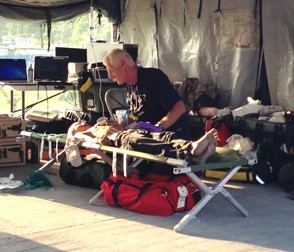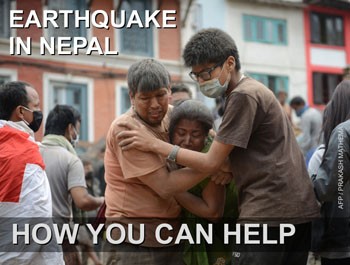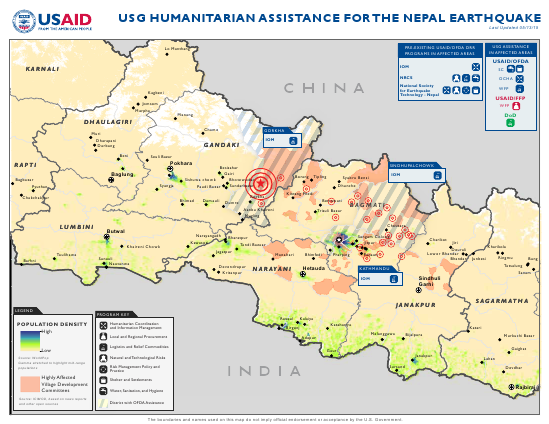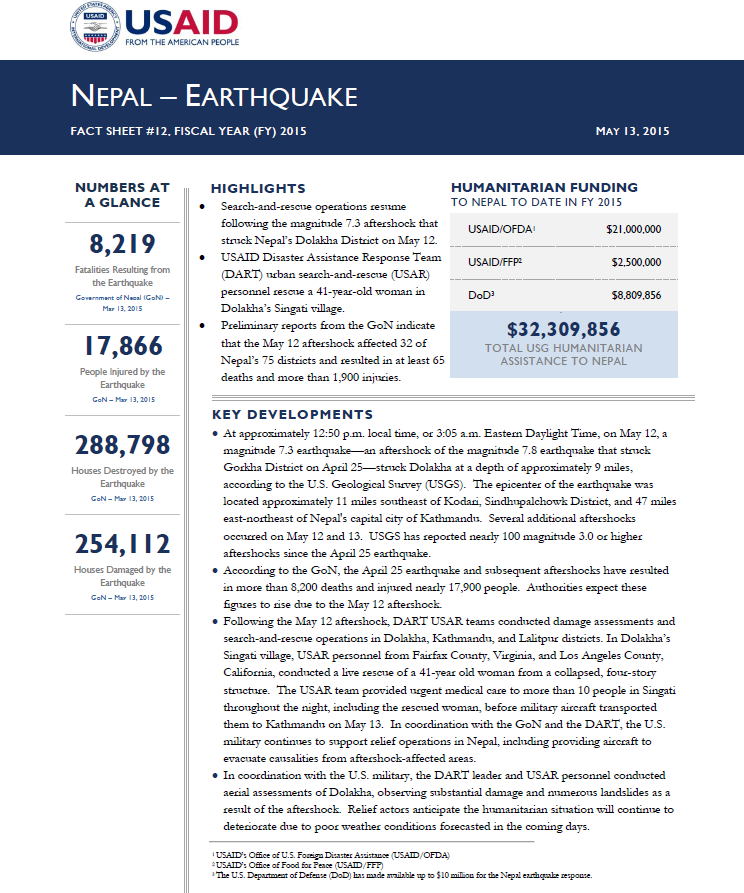May 13, 2015
Highlights
Search-and-rescue operations resume following the magnitude 7.3 aftershock that struck Nepal’s Dolakha District on May 12.
USAID Disaster Assistance Response Team (DART) urban search-and-rescue (USAR) personnel rescue a 41-year-old woman in Dolakha’s Singati village.
Preliminary reports from the GoN indicate that the May 12 aftershock affected 32 of Nepal’s 75 districts and resulted in at least 65 deaths and more than 1,900 injuries.
Key Developments
Nepal Earthquake Map - May 13, 2015 ![]() (pdf - 874k)
(pdf - 874k)
Numbers At A Glance
8,219
17,866
288,798
254,112
Humanitarian Funding:
To Nepal To Date In FY2015:
| USAID/OFDA | $21,000,000 |
| USAID/FFP | $2,500,000 |
| DoD | $8,809,856 |
| TOTAL | $32,309,856 |
Nepal Earthquake Fact Sheet #12 - 05-13-2015 ![]() (pdf - 364k)
(pdf - 364k)
At approximately 12:50 p.m. local time, or 3:05 a.m. Eastern Daylight Time, on May 12, a magnitude 7.3 earthquake—an aftershock of the magnitude 7.8 earthquake that struck Gorkha District on April 25—struck Dolakha at a depth of approximately 9 miles, according to the U.S. Geological Survey (USGS). The epicenter of the earthquake was located approximately 11 miles southeast of Kodari, Sindhupalchowk District, and 47 miles east-northeast of Nepal's capital city of Kathmandu. Several additional aftershocks occurred on May 12 and 13. USGS has reported nearly 100 magnitude 3.0 or higher aftershocks since the April 25 earthquake.
According to the GoN, the April 25 earthquake and subsequent aftershocks have resulted in more than 8,200 deaths and injured nearly 17,900 people. Authorities expect these figures to rise due to the May 12 aftershock.
Following the May 12 aftershock, DART USAR teams conducted damage assessments and search-and-rescue operations in Dolakha, Kathmandu, and Lalitpur districts. In Dolakha’s Singati village, USAR personnel from Fairfax County, Virginia, and Los Angeles County, California, conducted a live rescue of a 41-year old woman from a collapsed, four-story structure. The USAR team provided urgent medical care to more than 10 people in Singati throughout the night, including the rescued woman, before military aircraft transported them to Kathmandu on May 13. In coordination with the GoN and the DART, the U.S. military continues to support relief operations in Nepal, including providing aircraft to evacuate causalities from aftershock-affected areas.
In coordination with the U.S. military, the DART leader and USAR personnel conducted aerial assessments of Dolakha, observing substantial damage and numerous landslides as a result of the aftershock. Relief actors anticipate the humanitarian situation will continue to deteriorate due to poor weather conditions forecasted in the coming days.
LOGISTICS AND USAR
In coordination with the U.S. military, the DART leader and USAR personnel continue to conduct aerial assessments and search-and-rescue operations in affected areas. Since the May 12 aftershock, USAR personnel have conducted one live rescue, multiple evacuations, and provided emergency medical care to more than 20 people in Dolakha’s hard-hit Charikot and Singati villages.
According to the Multinational Military Coordination Center, nearly 2,500 injured people have been evacuated from aftershock-affected areas, including more than 1,400 evacuated by aircraft. The Nepalese Army has supported the evacuation of more than 1,300 people by aircraft, the UN Office for the Coordination of Humanitarian Affairs (OCHA) reports.
A combined medical team—comprising U.S. military personnel, USAR paramedics, and Nepalese Army first responders—has established a triage center at Kathmandu’s Tribhuven International Airport (TIA), where more than 50 injured people evacuated from aftershock-affected areas have received emergency medical support before being transported onward to local medical facilities in Kathmandu.
In addition to conducting medical evacuations and assisting with triage activities at TIA, U.S. military personnel continue to provide capacity for humanitarian cargo handling and offloading at TIA, in support of Nepal’s ongoing earthquake relief operations.
DISPLACEMENT
As of May 11, the International Organization for Migration (IOM) reported that 87 of 140 displacement sites—monitored by IOM’s Displacement Tracking Matrix (DTM)—in Kathmandu Valley remained open. Following the May 12 aftershock, additional populations sought shelter at GoN-identified displacement sites that were previously closed. In coordination with humanitarian partners, IOM continues to provide critical assistance to displaced populations in earthquake-affected areas.
Prior to the aftershock, DTM site assessments in Kathmandu Valley indicated that shelter and water, sanitation, and hygiene (WASH) support remained the priority needs of displaced populations. According to DTM, 70 percent of assessed sites had inadequate water supplies and shelter and lacked hand tools required to repair damaged shelters.
As of May 12, more than 100 people continued to shelter beside the UN’s humanitarian coordination hub in Sindhupalchowk’s Chautara municipality, and heavy rainfall, hail, and subsequent flooding continued to exacerbate the poor humanitarian conditions and health risks of displaced populations. Following the May 12 earthquake, an emergency evacuation site—currently hosting more than 350 people—was established, OCHA reported. In addition, OCHA noted that 50 people were sheltering at a site located approximately 2 kilometers from the UN’s humanitarian coordination hub.

PROTECTION
Relief actors continue to express concern that caste, gender, and religion, as well as the loss of documentation following the April 25 earthquake, may impede humanitarian assistance from reaching those most in need, OCHA reports. At the time of the 2011 census, nearly 320,000 female-headed households resided in Nepal’s most impacted districts. Due to significant outward migration of young men, more than a third of households in Gorkha, for example, are female-headed, with approximately one in five headed by women ages 60 and older, non-governmental organization (NGO) CARE reported in a recent rapid gender analysis. In Lamjung District, the share of female-headed households—approximately 40 percent—is far greater than Nepal’s national average of approximately 26 percent. OCHA and humanitarian partners are urging all relief actors to ensure the impartial and gender sensitive distribution of aid to earthquake-affected populations, including women who may have lost citizenship documentation. The DART and USAID/Nepal staff met with UK Department for International Development (DFID) representatives on May 12 to discuss protection issues following DFID’s field visits to Dhading, Ghorka, Lamjung, and Nuwakot districts. Based on their observations, DFID echoed concerns regarding vulnerable populations receiving inadequate assistance, particularly due to community cultures that require all affected individuals to receive the same assistance package rather than targeting assistance by need.
SHELTER
As of May 13, the GoN reported that the April 25 earthquake had damaged or destroyed more than 543,000 houses, not including houses damaged or destroyed by the May 12 aftershock. Relief agencies expect areas affected by the May 12 aftershock to require reassessment in the coming days, and OCHA anticipates an increase in the number of households requiring shelter materials and other relief commodities.
To date, cluster partners have distributed more than 134,400 tarpaulins, 7,800 tents, 16,400 household kits, and 19,600 blankets to earthquake-affected populations, according to OCHA. An estimated 500,000 additional tarpaulins are currently en route to Nepal, OCHA reports.
HEALTH AND WASH
Humanitarian organizations continue to caution that the fast-approaching monsoon rains may impede the delivery of critical humanitarian assistance to remote and hard-to-reach areas and further exacerbate the humanitarian situation in areas where WASH services have been disrupted. In preparation for the upcoming monsoon season, IOM is supporting the GoN and UN partners to conduct a cholera risk analysis. In addition, the GoN, with support from the UN World Health Organization, has developed an Early Warning and Response System (EWRS) for epidemic-prone diseases. The EWRS is actively monitoring confirmed and rumored reports of diseases in 14 of the most impacted districts.
As of May 13, the WASH Cluster—the coordinating body for humanitarian WASH activities, comprising UN agencies, NGOs, and other stakeholders—estimated that between 660,000 and 1.7 million people require WASH assistance, such as improved access to water and sanitation services, in affected districts; the cluster noted that the estimate will likely be revised in the coming weeks, as it does not include figures from the May 12 aftershock.
The WASH Cluster recently released its first 4W assessment, finding that approximately 64 percent of sanitation interventions implemented following the April 25 earthquake are primarily focused on the construction of emergency latrines, while an estimated 36 percent of sanitation interventions are focused on the repair of existing latrines. The majority of NGOs are prioritizing the distribution of water treatment chemicals, and nearly 60 percent of hygiene promotion activities consist of hygiene kit distribution. The WASH Cluster is also compiling baseline WASH data from 2014 to compare against the current emergency WASH situation at the village development committee (VDC) level. This comparison will allow WASH actors to differentiate between acute and chronic WASH needs and better define specific emergency interventions.
The Global WASH Cluster Rapid Assessment Team is conducting assessments to support and compliment GoN Department of Water Supply and Sewerage (DWSS) assessments, which are primarily focused on sanitation and hygiene. DWSS representatives from Gorkha and Nuwakot reported that the local water supply is generally adequate in each district, but WASH supplies—particularly hygiene kits—are not reaching remote areas. Cluster partners are coordinating with the Cash Working Group to explore cash-based options for essential hygiene items. Sanitation remains the biggest challenge in the two districts, according to DWSS.
As of May 13, more than 200 VDCs in 15 districts reported receiving WASH assistance, including temporary water supplies, water treatment products, sanitation facilities, and hygiene items, according to OCHA.
CONTEXT
On April 25, a magnitude 7.8 earthquake struck central Nepal at a shallow depth of approximately 15 kilometers (km), according to the USGS. The epicenter of the earthquake was located approximately 77 km northwest of Kathmandu, the country’s capital city, and 73 km east of Pokhara, another major city in central Nepal.
The USG immediately issued a disaster declaration for Nepal due to the effects of the earthquake. Within hours of the seismic event, USAID/OFDA had activated a RMT in Washington, D.C., and deployed a DART—including USAR specialists—to support emergency response efforts in Nepal.
For nearly two decades, USAID/OFDA has supported disaster risk reduction (DRR) efforts in Nepal, including throughout Kathmandu Valley. USAID/OFDA funding has enabled the International Organization for Migration (IOM) to identify, prepare, and preserve more than 80 open spaces in Kathmandu Valley to ensure the sites are available for humanitarian purposes—such as distribution centers or warehouses—in the event of large-scale disasters. USAID/OFDA has also supported NRCS to pre-position critical emergency relief supplies in order to address the immediate needs of affected communities following a disaster.
Through the Kathmandu-based National Society for Earthquake Technology (NSET), USAID/OFDA is strengthening Nepal’s earthquake response capacity by institutionalizing DRR at the local and national levels in collaboration with the GoN, non-governmental organizations, schools, and local communities. With USAID/OFDA support, NSET is also promoting public-private partnerships for earthquake risk management and enhancing the capacity of municipal governments to develop and administer building code permits and control systems to better protect against seismic activity.
PUBLIC DONATION INFORMATION
The most effective way people can assist relief efforts is by making cash contributions to humanitarian organizations that are conducting relief operations. A list of humanitarian organizations that are accepting cash donations for disaster responses around the world can be found at www.interaction.org.
USAID encourages cash donations because they allow aid professionals to procure the exact items needed (often in the affected region); reduce the burden on scarce resources (such as transportation routes, staff time, and warehouse space); can be transferred very quickly and without transportation costs; support the economy of the disaster-stricken region; and ensure culturally, dietary, and environmentally appropriate assistance.
More information can be found at:
- The Center for International Disaster Information: www.cidi.org or +1.202.821.1999.
-
Information on relief activities of the humanitarian community can be found at www.reliefweb.int.










Comment
Make a general inquiry or suggest an improvement.